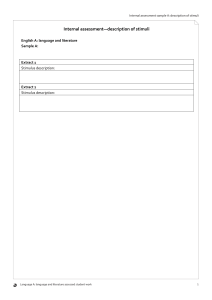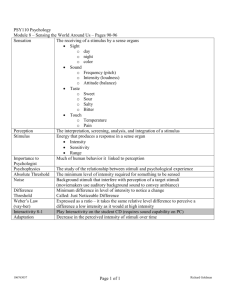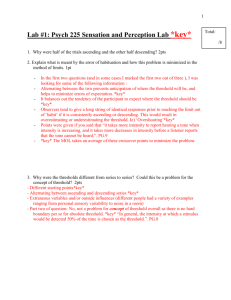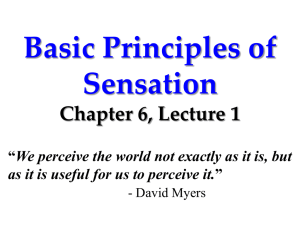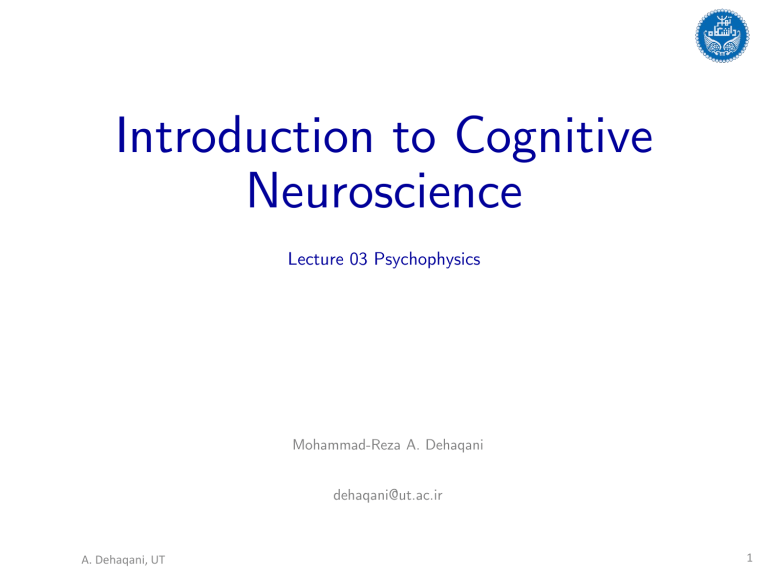
Introduction to Cognitive Neuroscience Lecture 03 Psychophysics Mohammad-Reza A. Dehaqani dehaqani@ut.ac.ir A. Dehaqani, UT 1 What is Psychophysics? Definition Methodology for investigating relationships between sensations in the psychological domain and stimuli in the physical domain Perception: The goal (task) of perception is to acquire accurate and reliable (precise) information about the environment. A. Dehaqani, UT 2 System neuroscience External stimulus Behavior A. Dehaqani, UT Brain 3 The power of psychophysics • • • Quantitative - objective scale of measurement • Valid inter-subject, inter-species, and inter-method comparisons Does not suffer from subjectivity of introspection Can be used to study “pure” mental phenomena - e.g. attention • • • • E.g. color perception in humans and bees Sensitivity of neurons vs. sensitivity of brains (humans) Can identify (possibly subconscious) response bias It is easy to setup A. Dehaqani, UT 4 Central to experimental psychology A. Dehaqani, UT 5 Psychometric Function • • A function from stimulus intensity to probability to perceive the stimulus Usually a S-shaped (cumulative normal distribution) A. Dehaqani, UT 6 Concept of threshold • Absolute threshold is the smallest amount of stimulus energy that can be reliably detected • Often called AL (absolute limen) or RL (Reizen Limen) Classical Threshold Theory A. Dehaqani, UT 7 Actual shape is not a step-function • Perceptual representation of a stimulus is not constant; it involves an additive random error. • Threshold is defined as the 50th percentile point A. Dehaqani, UT 8 Difference threshold • Difference threshold (DL: difference limen): is the smallest difference between two stimuli that can be reliably detected A. Dehaqani, UT 9 Weber’s Law • Difference threshold is proportional to the magnitude (intensity) of the stimulus: • W is called the Weber fraction: • DL grows linearly with I A. Dehaqani, UT 10 Perceived Magnitude • Fechner ’s Law: • Compare to Weber’s Law: JND: just noticeable difference A. Dehaqani, UT 11 Stevens’s (power ) Law: • One of the best established empirical laws in psychology A. Dehaqani, UT 12 Classical Psychophysical Methods Method of Constant Stimuli A. Dehaqani, UT 13 The Recipe • A set of equally spaced levels of the stimulus intensities is chosen (usually 5-9). • Each level is repeated large number of times in a given session (e.g. 100). • • The order of presentations is randomized. The subject is asked to report whether the presented stimulus can be detected (when AL is measured), or whether the intensity of the presented test stimulus is greater than that of the reference stimulus (when DL is measured). A. Dehaqani, UT 14 • The proportion of responses (YES) for each level of stimulus intensities is recorded and plotted against the stimulus intensity. A. Dehaqani, UT 15 Step By Step Example Light intensity Weak 1. 2. Strong Select a range of light intensities from certainly invisible to certainly visible Pick a few (4-7) points uniformly in this intensity range; this will be the constant stimulus set A. Dehaqani, UT 16 3. Test each stimulus many times (20-25) in random order … A. Dehaqani, UT 17 Each trial is: Visible? YES NO 4. Present the stimuli one at a time and ask the observer if it was visible or not A. Dehaqani, UT 18 Probability of perception 0% + 5. - 5% + + + 20% - - 50% - + 80% + + 95% 100% - - - - + Calculate the proportion of “yes” and “no” responses at each light level A. Dehaqani, UT 19 Percentage “seen” Drawing psychometric function 100% 75% 50% 25% 0% Stimulus intensity 6. Plot the percentages against stimulus intensity psychometric function A. Dehaqani, UT 20 Psychometric function for absolute thresholds Actual sigmoid function Ideal FIG (Sekuler) FIG (Sekuler) • • • Fixed absolute threshold Step function A. Dehaqani, UT • Absolute threshold varies somewhat from trial to trial (due to constant fluctuations in sensitivity) Conventionally, the intensity corresponding to 50% is considered to be the threshold 21 measuring difference thresholds Standard stimulus: Comparison stimuli: Light intensity 1. Standard stimulus has a fixed intensity 2. The intensities of comparison stimuli are in the spectrum A. Dehaqani, UT 22 3. All pairs of standard and comparison stimuli are tested many times A. Dehaqani, UT 23 STRONGER 4. WEAKER For each pair, the observer judges if the comparison stimulus was stronger or weaker than the standard http://www.yorku.ca/psycho A. Dehaqani, UT 24 Percentage “stronger” 5. 100% 75% 50% 25% 0% Light intensity of comparison stimuli For each comparison level, the percentage of “stronger” responses is calculated and results are plotted as a psychometric function A. Dehaqani, UT 25 Percentage “stronger” PSE concept in difference thresholds method 100% 75% 50% 25% 0% PSE Light intensity of comparison stimuli • When the observer cannot see a difference, he/she chooses randomly between “stronger” and “weaker”; this corresponds to 50% on the psychometric function point of subjective equivalence (PSE) A. Dehaqani, UT 26 Percentage “stronger” 100% 75% 50% 25% 0% DW DS Light intensity of comparison stimuli • • • By convention, the intensity at 75% is considered to be just noticeably stronger than the standard DS A comparison intensity at 25% is just noticeably weaker than the standard DW Difference threshold = the average of DS and DW A. Dehaqani, UT 27 Method of Limits A. Dehaqani, UT 29 To find absolute threshold –AL(ascending series) 1. A series begins with a stimulus intensity well below threshold, at a value that will be called the lower limit. 2. Stimulus intensity is increased using small steps until it reaches the upper limit. 3. On each trial the subject responds whether she can perceive the stimulus. 4. Threshold for this series is estimated as the midpoint between the stimulus intensities for the last NO response and the first YES response. A. Dehaqani, UT 30 AL (descending series) 1. A series begins with a stimulus intensity at the upper limit. 2. Stimulus intensity is decreased using small steps until it reaches the lower limit. 3. On each trial the subject responds whether she can perceive the stimulus. 4. Threshold for this series is estimated as the midpoint between the stimulus intensities for the last YES response A. Dehaqani, UT 31 Method of Limits DL (symmetric design): • In the symmetric design, the lower limit is well below PSE and the subject’s task is to decide whether the test is greater or less than the reference. A. Dehaqani, UT 32 Method of limits for measuring absolute thresholds + + Light intensity • + + + + + + + - + + - - - - - - - Trials A. Dehaqani, UT • • Ascending and descending series may yield different results use both Even in the same direction, there is variability in the threshold (inner noise, etc) average many measurements Measured threshold corresponds to 50% point in a psychometric function (method of constant stimuli) 33 Light intensity of comparison stimulus Method of limits for measuring difference thresholds • + + + + + + + threshold + estimate - - + + + + - - - • - Trials + comparison brighter • Intensity of the comparison stimulus is decreased (descending) or increased (ascending) until the response changes Threshold estimate: intensity difference between the standard and comparison stimuli where the response changes Average results from multiple series in both directions - comparison weaker A. Dehaqani, UT 34 Method of Adjustment A. Dehaqani, UT 35 To detect AL The subject is asked to adjust the intensity of the stimulus so that it is just barely detectable. The value adjusted is taken as an estimate of the threshold. Note the asymmetric nature of this experiment caused by the fact that the intensity of the stimulus is never negative: The subject is asked whether the stimulus is present (greater than zero), or absent (zero). This fact makes the estimate of AL very sensitive to response bias A. Dehaqani, UT 36 Method of adjustment for measuring absolute thresholds • • • Observer can vary the stimulus intensity Instructed to adjust it so that it is just visible or just invisible Initial intensity is set to be far from the expected threshold value adjustment device See: Simple_Null_Luminance.m A. Dehaqani, UT stimulus with adjusted intensity observer 37 Method of adjustment for measuring absolute thresholds • threshold estimate • • descending ascending • • Adjustment: by a real or a software device (e.g. knob, slider) A. Dehaqani, UT • Threshold estimate: final intensity value Descending: initial intensity is well above expected threshold; adjusted to just visible Ascending: initially well below threshold; adjusted to just invisible Ascending and descending task repeated several times and results averaged Similar to method of limits but observers find it easier 38 Adaptive Psychophysical Methods A. Dehaqani, UT 39 What Do We Mean by “Adaptive”? The stimulus intensity level on any one trial is determined by the preceding stimuli and responses A. Dehaqani, UT 40 Why Adaptive Method • Compared with other methods (e.g., constant stimuli, signal detection), adaptive method places most of the stimuli at intensity levels close to the threshold that is being measured • Adaptive method allows for more efficient estimation of thresholds A. Dehaqani, UT 41 Simple Up-Down Method (Staircase Method) • Adaptive methods reduce the number of trials at the stimulus intensity levels • Staircase method is analogous to the method of limits, except that • an ascending (descending) sequence does not terminate after the first reversal from NO to YES (YES to NO) response. • Instead, the experiment continues until many reversals are obtained around the value to be estimated. A. Dehaqani, UT 42 Staircase for detection Source: http://webvision.med.utah.edu/Psych1.html A. Dehaqani, UT 43 • The simple staircase method estimates the 50% point of the psychometric function. A. Dehaqani, UT 44 Adaptive Step Size • At the start of an experiment, a large step size is used • The step size is gradually decreased during the course of the experiment • Half the step size after a fixed number of trials A. Dehaqani, UT 45 Adaptive Staircase Source: http://webvision.med.utah.edu/Psych1.html A. Dehaqani, UT 46 Stimulus Generation for Vision Psychophysics Contrast, Orientation Motion A. Dehaqani, UT 47 contrast 25% 75% See contrastBlob.m A. Dehaqani, UT 48 Orientation and Spatial Frequency See Gabor.m A. Dehaqani, UT 49 Motion Drifting gratings A. Dehaqani, UT 50 Exercise: How to estimate the size of this illusion? See: ebb_const.m A. Dehaqani, UT 51 Curve fitting and quantitative analysis A. Dehaqani, UT 52 Curve fitting: why should we care? • • Summarize all acquired data and increase power Translate raw data into variables that inform about different aspects of data (e.g. bias, sensitivity, gain, adaptation) • Enables quantitative comparison of findings across conditions A. Dehaqani, UT 53 Psychometric function λ β, α See IllustrationCruves.m γ A. Dehaqani, UT 54 Logistic Function 1 F(x,a,b) = 1 + e-b(x-a) a’ < a a λ b 50% γ b’ > b a A. Dehaqani, UT b 55 Cumulative Gaussian Carl F Gauss σ2 λ 50% γ A. Dehaqani, UT μ 56 Cumulative Weibull λ Waloddi Weibull 81% β γ α A. Dehaqani, UT See curves.m for application Also see http://www.bootstrap-software.org/psignifit/ 57 A. Dehaqani, UT 58
